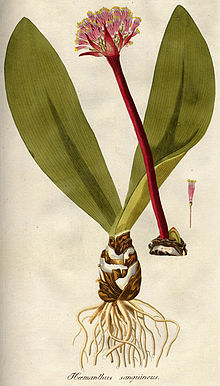Haemanthus sanguineus
| Haemanthus sanguineus | |
|---|---|

| |
| Plate from Plantarum Rariorum Horti Caesarei Schoenbrunnensis Descriptiones et Icones 1797-1798 | |
| Scientific classification | |
| Kingdom: | Plantae |
| Clade: | Tracheophytes |
| Clade: | Angiosperms |
| Clade: | Monocots |
| Order: | Asparagales |
| Family: | Amaryllidaceae |
| Subfamily: | Amaryllidoideae |
| Genus: | Haemanthus |
| Species: | H. sanguineus
|
| Binomial name | |
| Haemanthus sanguineus | |
| Synonyms[1] | |
| |
Haemanthus sanguineus is a South African bulbous geophyte in the genus Haemanthus that occurs in the fynbos vegetation of the Western Cape.
This endemic fynbos geophyte is dormant during the summer and cannot be seen. In the autumn a striking crimson inflorescence emerges from the ground. This consists of a crimson stem that bears a mass of tiny red, crimson and yellow individual flowers.
The plant then produces two circular leathery leaves in the autumn and winter. These lie flat on the ground and are typically edged with scarlet hairs. They are a deep green on the upper surface and underneath are covered in pink and red spots.
See also[edit]
Gallery[edit]
Wikimedia Commons has media related to Haemanthus sanguineus.
-
The inflorescence
-
The flat, rounded leaves
References[edit]
- ^ "The Plant List: A Working List of All Plant Species". Retrieved 18 February 2015.
External links[edit]
- Dressler, S.; Schmidt, M. & Zizka, G. (2014). "Haemanthus sanguineus". African plants – a Photo Guide. Frankfurt/Main: Forschungsinstitut Senckenberg.


